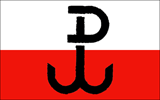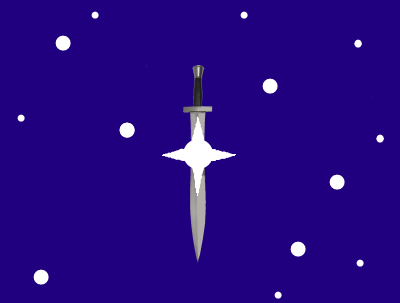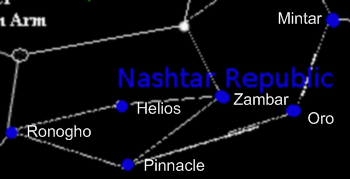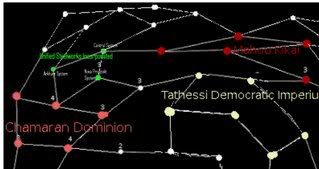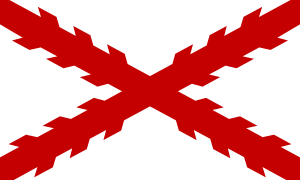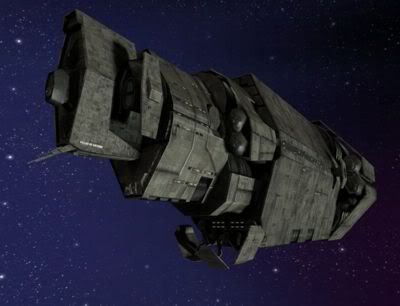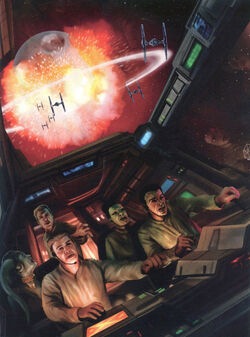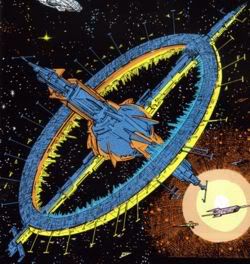Current Map:

The Star Kingdom of Kaeleer
Navy: 1250 points
General Notes on Kaeleerian Ship Design: The Royal Kaeleerian Navy has long focused on creating ships with the most devastating collection of weaponry possible, and this priority combined with the standard "wall of battle" formation has resulted in ships with a truly massive broadside collection of missile launchers and turbograser cannon, collections of point defense weaponry scattered across the top and bottom of the ship. Note that smaller ships, generally of cruiser size and below, have weapons distributed more evenly. Additionally, the fleet is currently undergoing an upgrade cycle, with most ships being replaced by more powerful types. In particular, superdreadnoughts are beginning to subvert the dreadnought's traditional place at the head of Kaeleer's fleets, and a design for a heavy cruiser has already been approved.
Weaponry:
Missiles: The primary offensive weapon of the Star Kingdom's ships are missile launchers, ranging in size from the small antifighter launchers aboard destroyers to the huge assault launchers mounted on superdreadnoughts. Because of this, Kaeleeri ships mount phenomenal collections of countermissiles, reasoning that they ought to be able to defend against their own weapons.
Turbograsers: There are occasions when the vicissitudes of fate draw fleets too close together for effective missile use. In light of this, the turbograser is a standard weapon on most of Her Dark Majesty's ships. Like missile launchers, there is great variety in size; superdreadnoughts mount cannons the size of some ships.
Point Defense Lasers: These purely defensive weapons are usually mounted in mixed batteries with countermissile launchers, the better to provide an effective defense. They are intentionally low-powered, relying on the speed generated by their target to provide the energy for it's own destruction.
Naval Prefix: HDMS; Her Dark Majesty's Ship.
[5 Planned] SD (Victory-class superdreadnought) 100 500 pts
This design is to be as the Unbending-class is now - The core of Kaeleer's fleets, the bane of her enemies and the succor of her friends. Unfortunately, the design has thus far proved prohibitively expensive.
5 SD (Unbending-class superdreadnought)-60 300 pts
The Unbending-class was designed as the ultimate expression of Kaeleer's military power. The ships of this class carry extensive command facilities, having been designed to serve as the flagships of Her Dark Majesty's fleets, and bristle with the heaviest cannons and the largest missile tubes ever mounted on a Kaeleerian warship.
[10 planned] CFV (Aviary-class fleet carrier)-60 600 pts
Intrigued by the success of carrier-based navies, the Admiralty has ordered a design study to be conducted on a large carrier for Her Dark Majesty's Navy. This is the result, and simulations have shown it to be as powerful as an Unbending-class superdreadnought.
10 DN (Vanguard-class dreadnought)-30 300 pts
The main strength of the Star Kingdom's forces are the Vanguard-class, as heavily armed as any ship of comparable size and carrying massive amounts of armor and shield generators. They are nonetheless being phased out in favor of the Unbendings.
20 BC (Vigorous-class battlecruiser)-20 400 pts
Less indestructible than the Vanguards, Vigorous-class battlecruisers mount the same number of weapons as well as a much more powerful engine system.
[20 Planned] CBV (Haven-class battle carrier)-25 500 pts
A part of the Carrier Design Study ordered by the Admiralty, these lighter carriers are intended to help shape a battle by driving lighter units towards the Kaeleerian wall.
[40 Planned] CA (Persecution-class heavy cruiser)-10 400 points
These ships, as massive as some older battlecruiser designs, are planned as an upgrade to the aging Crescent class. They will replace the ships as fleet units, allowing the Her Dark Majesty's light cruisers to be used for pirate suppression and independent patrol.
40 CL (Crescent-class light cruiser)-4 160 pts
The mainstay of Kaeleer's navy is the units of cruisers assigned to each fleet. Too small to form a part of the wall of battle, they are still more than able to destroy any light warship, and squadrons are frequently assigned to help shape a fleet action by forcing enemy units toward the more powerful elements.
[10 Planned] CLS (Morgana-class stealth light cruiser)-8 80 pts
Distinctly lacking from the Star Kingdom's fleet lists are any sort of covert operations ship. The Morgana-class ships, a design based on the Crescent-class hull, will serve to repair this absence, if they're ever built.
50 DD (Amethyst-class destroyer)-1 50 pts
Swift but fragile, Her Majesty's destroyers serve as scouting units for the rest of a fleet.
[Indeterminate Number Planned] SSF (Viper-class space superiority fighter)- {Cost included in carrier}
Yet another product of the Carrier Design Study, the heavily-armed Viper is intended to sweep enemy fighters from space with a pair of missile launchers and three light grasers.
[Indeterminate Number Planned] SSB (Hornet-class space superiority bomber)- {Cost included in carrier}
These ships, when constructed, are designed to swamp enemy point defense in powerful (for fightercraft) warheads.
Ebon Askavi Fleet - The most prestigious force in the Star Kingdom is the fleet charged with defending the Queen's residence - and also the lion's share of Kaeleer's industrial might. (242 pts.)
1 SD - Unbending
2 DN -Vanguard, Undaunted
4 BC - Superb, Valiant, Fame, Zealous
8 CL -Argos [damaged], Diadem, Crescent, Aurora [destroyed], Immortalie, Mystery, Warspite, Imperieuse
10 DD -Daring [crippled], Decoy, Conflict, Teazer, Wizard [crippled], Banshee, Contest, Dragon, Handy, Violet [effectively destroyed]
Arceria Fleet - The Arceria system was colonized by an Eyrien sleeper fleet roughly thirty years before the arrival of humans in the Star Kingdom, and is the second-most populated region, after Ebon Askavi. (242 pts.)
1 SD - Champion
2 DN - Resolution, Dauntless
4 BC - Excellent, Illustrious, Fortitude, Vengeance
8 CL - Leviathan [destroyed], Antrim, Warrior, Natal [destroyed], Minotaur, Comus, Legionnaire, Constance
10 DD - Myrmidon, Syren, Star, Wistful, Kennet, Test, Nith, Ness, Blackwater, Gala
Dharo Fleet - Dharo is the most pleasant system in the Star Kingdom - Free of Ebon Askavi's heavy industries to darken the skies of it's planets, and it's Queen is less strict about upholding the Blood's moral code than many others. (242 pts.)
1 SD - Sovereign
2 DN - Majestic, Indomitable
4 BC - Indefatigable, Defiance, Ardent, Formidable
8 CL - Phaeton, Leander, Chalice, Forth, Magicienne, Medusa, Sirius, Rainbow
10 DD - Arun, Yare, Liffey, Colne, Teviot, Scourge, Savage, Renard, Pincher, Talisman
Nharkava Fleet - Under the leadership of Queen Cassandra Angelline, the Queen of the Darkness almost three hundred years ago, Nharkava was colonized from Ebon Askavi by a mix of Eyriens and humans, leading to it's current status as the place in the Star Kingdom where the two races mix most freely. (242 pts.)
1 SD - Magnificent
2 DN - Thunderer, Regal
4 BC - Vigorous, Inflexible, Courageous, Glorious
8 CL - Pioneer, Sprite, Cambrian, Pomone, Forte, Flora, Bonaventure, Astraea
10 DD - Scout, Seraph, Stirling, Tribute, Tactician, Valiant, Valkyrie, Valentine, Vampire, Wakeful
Dhemlan Fleet - Dhemlan is best noted as the home system of the current Prince Regent, Saetan SaDiablo. Also, it's asteroid belt provides most of the rarer metals used in Ebon Askavi's shipyards. (242 pts.)
1 SD - Imposing
2 DN - Implacable, Unstoppable
4 BC - Repulse, Resistance, Furious, Invincible
8 CL - Peregrine, Highflyer, Pearl, Challenger, Encounter, Rover, Hazard, Tribulation
10 DD - Amethyst, Diamond, Sapphire, Ruby, Emerald, Opal, Garnet, Topaz, Agate, Carnelian
Remembrance Fleet - Composite Unit - Replaces Arceria and Ebon Askavi Fleets (467 points)
2 SD
4 DN
8 BC - 1 damaged
12 CL
17 DD
Formal Long Name
The Star Kingdom and Royal Dominions of Kaeleer
Conventional Short Name
Kaeleer; the Star Kingdom of Kaeleer
Government Type
Absolute Monarchy
Notables
Jaenelle Angelline, Queen of Kaeleer and of the Darkness, Black Caste
Saetan SaDiablo, Regent of Kaeleer, Steward of the Dark Court, Prince of the Darkness, Black Caste
Daemon Sadi, Consort of the Dark Court, Prince of the Darkness, Black Caste
Tersa the Stranger, High Priestess of the Kaeleerian Hourglass, Lady of the Darkness, Red Caste
Andulvar Yaslana, Master of the Queensguard, Duke of the Darkness, Ebon-gray Caste
Lucivar Yaslana, First Escort of the Dark Court, Duke of the Darkness, Ebon-gray Caste
Morghann Maghre, Queen of Arceria, Blood Queen, Green Caste
Khardeen Maghre, Chancellor of the Exchequer, Blood Prince, Sapphire Cast
Karla Halaway, Queen of Dhemlan, Blood Queen, Gray Caste
Surreal SaDiablo, Admiral of the Fleet, Commander of Dhemlan Fleet, Blood Lady, Gray Caste
Kalush Nharkava, Queen of Nharkava, Blood Queen, Red Caste
Aaron Nharkava, Admiral of the Fleet, Commander of Nharkava Fleet, Blood Duke, Gray Caste
Alexandra Leland, Queen of Dharo, Blood Queen, Opal Caste
Philip Alexander, Admiral of the Fleet, Commander of Dharo Fleet, Blood Duke, Purple Dusk Caste
Arabella Nehele, Ambassador to Unity Station, Blood Countess, Sapphire Cast
Ardelia Nehele, High Priestess of the Unity Hourglass, Blood Lady, Opal Cast
Society
A rigid caste structure governs the life of each Kaeleerian, itself laid out by religious mandate and centuries of tradition. There are 13 castes , corresponding to the thirteen levels of the Darkness, an abstract concept of security and comfort worshipped by the citizens of Kaeleer, both human and Eyrien, since time immemorial. The castes descend from White to Black, with only the Queen and her immediate family belonging to the black. Kaeleerians dress in the color of their caste, so one could be said to "wear the Green", for example.
* White
* Yellow
* Tiger Eye
* Rose
* Summer-sky
* Purple Dusk
* Opal
* Green
* Sapphire
* Red
* Gray
* Ebon-gray
* Black
Social rank and also impact a Kaeleerian, with the hereditary nobility (Blood) holding the majority of power in the government and military. Military rank is, however, considered more important than social rank but less important than caste rank, so a Summer-sky Colonel with no title would socially outrank a Summer-sky Captain who is also an earl, while being himself outranked by a Gray Colonel or a Summer-sky Colonel who holds a title. In military situations, military rank matters the most, but otherwise one's position in the hierarchy is dependent on who is in the room.
Eyriens, winged humanoids from the planet Ebon Askavi, make up roughly a third of Kaeleers population, but a disproportionate number of them serve in the military, roughly half. Pre-colonization Eyrien titles and castes are used almost interchangeably with the more common ones, with lighter castes referred as Warlords, if male, or witches, if female, and darker cast members Queens, Warlord Princes, Princes, or Black Widows. The Black Widows, also known as the Hourglass Covens, serve as the Star Kingdom's intelligence service.
Planetary Point Distribution
Ebon Askavi System (100 points)
-Ebon Askavi (50 point homeworld, military fortress world, shipbuilding)
-Ebon Rih (10 point moon, heavy industries)
-Riada (20 point planet, agriculture)
-Doun (20 point planet, heavy industries and base for Navy weapons testing)
Arceria System (40 points)
-Arceria (20 point planet, asteroid refining)
-Chaillot (20 point planet, military fortress world, asteroid mining)
Dharo System (30 points)
-Dharo (10 point planet, agriculture and tourism)
-Khary (10 point moon, light industries)
-Chaosti (10 point planet, military fortress world)
Nharkava System (30 points)
-Nharkava (20 point planet, military fortress world and heavy industries)
-Scelt(10 point planet, agriculture)
Dhemlan System (50 points)
-Dhemlan (40 point planet, military fortress world and light shipbuilding)
-Amdarh (10 point planet, light industries and agriculture)



